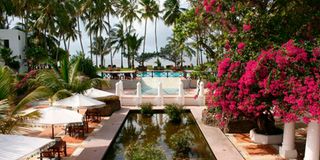Swahili style and sea turtles

The view across Sokoni Plaza at Serena Beach Resort & Spa.
‘Hi Mr Fox, the turtles are hatching!’ I was in my room when I got the call, recovering from an overindulgent lunch. I hauled my buffet belly off the bed and ran as quickly as I could to the spa, where my pampered partner, Gabie, was getting her nails done. I told her the news, and we both jogged over to the hatchery on the beach.
Here, we met Marsden, the resort’s head of guest activities, and our guide for the afternoon. Beside him were three meshed hatching enclosures, and in a corner of one of them were two tiny, frantically flapping green turtles. Marsden opened the door and they made a mad dash for the water, stumbling awkwardly on clumps of seaweed and ridges in the sand.
In no time they were swept up by the surf, and on their journey across the vast, perilous ocean. As they bobbed in the waves, I hoped that they would defy the odds and survive to adulthood.
But just by making it into the sea, they’ve been afforded a better start to life than many other hatchlings. The Serena Beach Resort & Spa have been running their Turtle Conservation Project for 28 years.
Insecure nests
They monitor and protect nest sites on the surrounding beaches from poaching, tidal flooding and other threats. And, as a last resort, insecure nests are moved to their own hatchery to be looked after. Since the project started in 1993, they have helped to release over 65,000 turtles into the sea.
The next morning, we caught a glimpse of an adult green turtle, too. It poked its head out of the water as we sailed down the coast in a catamaran, handled expertly by the captain, Hassan. We skirted the edge of the Mombasa Marine Park, where we also spotted an inquisitive blacktip reef shark, hunting in the shallows.
From the catamaran, we had a wide view of the coastline, all the way down south to the headland past Bamburi Beach. On Shanzu Beach, Serena’s understated design really stood out beside its neighbouring, concrete eyesores. As Marsden explained on our ‘cultural tour’ the previous day, privacy is a key part of the resort’s Swahili-inspired architecture.
‘The aim was to replicate a traditional Swahili village, especially the old town of Lamu. There the houses are very close together, but you won’t find a road or path that is straight. This is because Swahili people are very private, and like to keep things to themselves.’
The architects did an excellent job, particularly in the Village Wing. Here, along twisting alleyways, are clusters of makuti-roofed rooms, with intricately carved wooden balconies. Our first-floor room had a sea view, but I wouldn’t have minded a room further back, lost in the branches of a frangipani tree, or beside a landscaped courtyard.
Heavy Lamu doors
The Swahili design influences run throughout the resort, from heavy Lamu doors, to a high, airy foyer ceiling, and a minaret poking above the palm trees. And everywhere there is a more subtle detail – a Swahili motif in the shape of a turtle, in recognition of their conservation project.
In the far corner of the resort, just a few yards from the breaking waves, is the Jahazi Grill, where we enjoyed our final dinner. As its name implies, Jahazi has been creatively designed to resemble a large dhow, with sanded decks, ropes and other rigging.
The restaurant specialises in seafood, but we were served a delicious paneer curry alternative as vegetarians. Our waiter, Kennedy, and chef, Geoffrey, really went out of their way to make sure there were enough options for us on the menu.
In their architecture, cuisines and experiences, Serena’s hotels and lodges are known for drawing inspiration from their surrounding environments and cultures. At the Serena Beach Resort & Spa it’s no different, and they’ve done a fantastic job of it, too.
For bookings, head to www.serenahotels.com, or call 0727 424200.





